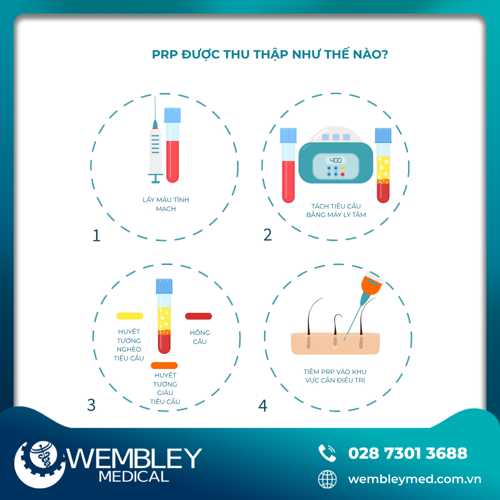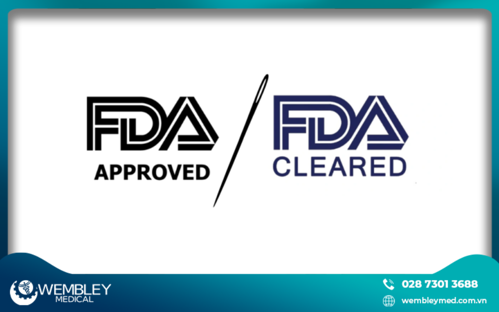
- Home
- About Us
- Advisory Board
- Products
- Services
- News
- Distributors
- Contact Us
- Search
- Lot I-10-7, D7 Street, Saigon Hi-Tech Park, Tang Nhon Phu Ward, Thu Duc City, HCMC(+84) 28 7301 3688Info@wembleymed.com.vn
Platelet-Rich Plasma (PRP) is extracted from human whole blood and contains a high concentration of growth factors capable of promoting the body’s natural healing processes. What is the stance of the U.S. Food and Drug Administration (FDA) on PRP therapy?
To address this question, it is first essential to understand how PRP is collected and applied in clinical settings. Additionally, it is important to clarify the distinction between the terms “FDA approval” and “FDA clearance for use.”
PRP-based treatments have been implemented in clinical practice for nearly two decades. Commonly referred to as PRP, this therapy utilizes the platelet-rich component of a patient’s autologous whole blood to support the treatment of various sports-related injuries, a wide range of chronic conditions, and numerous musculoskeletal disorders.
Technicians remove whole blood from patients before placing it in a centrifuge to pull out the platelet-rich portions. When whole blood is spun, it separates into three distinct layers: red blood cells, a so-called “buffy coat” of white cells mixed with platelets and a third, topmost layer that mostly contains platelets.

In fact, there are two methods for preparing PRP, known as the “PRP method” and the “buffy coat” method. The processes are very similar and each one combines the whole blood with an anti-coagulant before placing it in a centrifuge. It is important to note that both the buffy coat” and the PRP method have been FDA-approved ways of preparing PRP since 2009.
PRP treatments have a number of useful applications for people who suffer from a wide range of conditions that include neuropathy (nerve pain) and injuries to the musculoskeletal system. Additionally, practitioners use PRP in both cosmetic and plastic surgery. What are the specific applications of PRP in each of its most commonly used applications? The following chart offers a delineation of uses within the four categories:
One of the most common modern uses of PRP is in the field of sports medicine to treat a host of orthopedic injuries and disorders. Many patients are able to avoid surgery by employing PRP therapy. An added benefit is the faster healing time that PRP treatment can usually bring about for those who want to get back to their normal daily routines as quickly as possible. Some of the conditions that PRP has shown to be effective at treating include arthritis, osteoarthritis, carpal tunnel, sprains, epicondylitis, rotator cuff injuries and lumbar pain.

One of the more recent uses of PRP is related to nerve injuries, specifically PN, or peripheral neuropathy. Several studies have been conducted that attempted to measure PRP’s effectiveness in the treatment of nerve injury. Since 2012, platelet-rich plasma therapies have been used to decrease nerve pain associated with PN.
People who wish to decrease the number of wrinkles in their face, hands and neck areas often turn to PRP treatments. While not associated with pain relief in these applications, PRP has been shown to help speed up the healing process after hair transplants. There is even evidence that hair transplant patients who use PRP therapy show faster hair growth after the procedure.

One of the more popular uses of PRP is in the field of plastic surgery because platelet-rich plasma has the potential to speed up the natural healing process immediately following a skin graft or similar procedure. Evidence of this benefit of PRP is documented in more than 3 dozen controlled, randomized clinical trials and case studies from both the Cochrane and PubMed libraries. That data substantiated the benefits that PRP delivers for speedy wound healing.
In another major study, injected PRP was shown to facilitate the regeneration of nerve tissue. Sanchex et al treated a subject who suffered from an apparently intractable case of nerve-related palsy and related issues. After nearly a year of conservative treatment that produced no measurable results, PRP injections were administered. His muscle activity showed a clear improvement and he was even able to walk rapidly and run without having to use an orthotic device.
Because PRP is technically considered a “biologic” under FDA definitions, and because devices are used to prepare PRP, the government agency is intimately involved in both clearance and approval for PRP treatments and devices used to make PRP.

Right now, the huge majority of devices used to make PRP are cleared by the FDA. As for PRP treatments themselves, because they use a person’s blood and are not considered to be “drugs,” the treatments are not subject to FDA approval before they can be used by practitioners.
It’s important to understand that many procedures and treatments that are widely used in clinical settings are not approved by the FDA but are allowed because they are listed as being “cleared” for use. This is the situation with both PRP therapies and the devices, centrifuges, that are used to prepare PRP samples.
There is also no FDA approval for sports-related PRP treatments. Even so, one of the most common PRP treatments in current use is in the field of sports medicine and the effective treatment of sports injuries. PRP’s potential to bring about faster healing is the key reason that so many people turn to it after a sport-related injury.
Currently, FDA approval is pending for the treatment of tendonitis with injections. However, in the case of diabetic ulcers that resist healing, and in some instances of orthopedic surgery, the FDA has approved PRP treatment regimens.
What’s the “bottom line” about PRP and FDA approval? Where the treatment is used in surgical and/or medical management, the FDA certainly does not object to the treatment. That’s why it can be said that both the treatment and the device used to prepare PRP are both “cleared” by the FDA, rather than “approved.” PRP is a natural substance that comes from the human body. It is not a “drug.” Perhaps that’s why there has been confusion among some members of the treatment community and the public about this issue. The “D” in “FDA,” stands for “drug.” Because platelet-rich plasma is not a drug, practitioners are currently allowed, both legally and ethically, to use PRP therapy for the good of their patients.

Fundamentally, when PRP therapy is utilized in medical management and/or surgical procedures, the FDA does not object to its use. Therefore, it can be stated that both the treatment modality and the devices used for PRP preparation are cleared rather than approved. PRP is a naturally derived biologic product obtained from the patient’s own body—it is not classified as a drug. This distinction likely contributes to the ongoing confusion among healthcare providers and the general public regarding the relationship between PRP and the FDA. The “D” in “FDA” stands for “Drug,” and since PRP does not fall under this category, physicians are legally and ethically permitted to administer PRP therapy in the best interest of their patients.
PRP is a safe, natural, and legally accepted therapy for the treatment of various medical conditions. Although not “approved” as a pharmaceutical drug, both PRP and PRP preparation devices have been cleared by the FDA for legal use in medical and surgical applications. This is why physicians can confidently incorporate PRP therapy into their clinical practice, in the best interest of their patients.
Vactracy PRP Platelet Rich Plasma Isolation Kits by WEMBLEY MEDICAL is a professional solution designed to standardize the PRP procedure for the treatment of hair loss, ensuring optimal safety and clinical outcomes. For more information about the product, please contact our Hotline at 028 7301 3688 for immediate consultation and support.